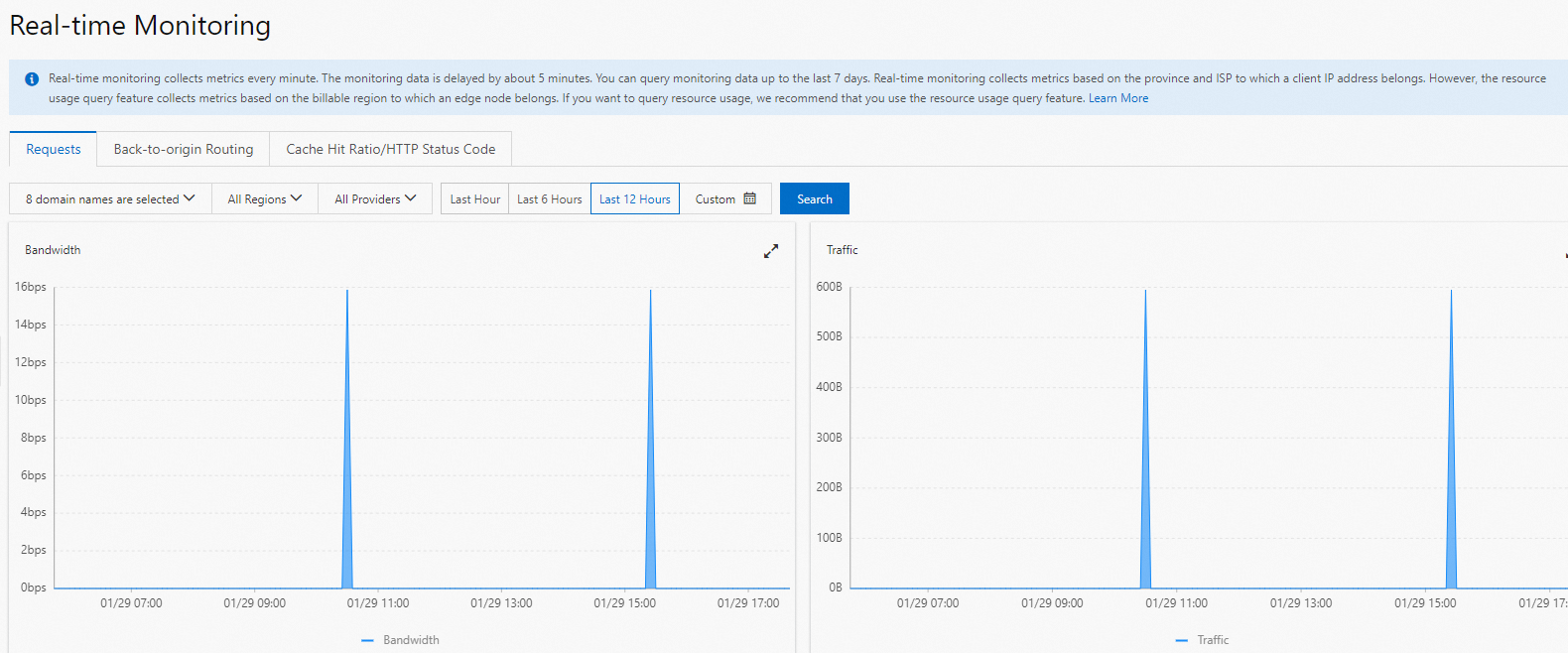The real-time monitoring feature collects data at a 1-minute granularity. You can view traffic, bandwidth, and origin fetch status for CDN and from the previous minute. You can query data from the last 7 days. The maximum timestamp range for a single query is 24 hours. The 1-minute real-time monitoring data helps you quickly detect CDN and traffic exceptions and locate issues.
Features
Compared to Resource Monitoring, real-time monitoring provides a shorter query time range and lets you access historical data for a shorter period, as shown in the following table.
Supported time granularities for queries
You can query monitoring data using the console or by calling API operations. The following table describes the maximum timestamp range for a single query, data latency, and the time range for historical data queries at different time granularities.
The following are the time granularity, the maximum time span for a single query, and the queryable time range for historical data:
Query data in the console:
Time granularity
Maximum time range per query
Historical data available
Data latency
1 minute
1 hour
7 days
5 minutes
5 minutes
3 days
7 days
15 minutes
Query data by calling API operations:
Time granularity
Maximum time range per query
Historical data available
Data latency
1 minute
1 hour
7 days
5 minutes
5 minutes
3 days
93 days
15 minutes
1 hour
31 days
186 days
4 hours
Metrics and monitoring indicators
The real-time monitoring feature includes three metrics. You can select a domain name, region, carrier, and time range to view details about monitoring indicators such as bandwidth and traffic.
Real-time monitoring collects data based on client IP addresses. In contrast, billing is calculated based on the traffic, bandwidth, and number of requests on CDN points of presence (POPs) in each billable region. The results from these two methods may differ because different statistical methods are used. The line charts for real-time monitoring are mainly used to show bandwidth trends. To query the metering data that corresponds to your bills, see Usage overview.
Data is calculated and collected by calling API operations. For more information, see the API references in the following table.
Metric | Metrics | Related API operations |
Access Data | Displays the bandwidth, traffic, number of requests, and queries per second (QPS) for accelerated domain names. | |
Origin Fetch Data | Displays the back-to-origin bandwidth and back-to-origin traffic for accelerated domain names. | |
Hit Rate/Status Code | Displays the request hit ratio, byte hit ratio, and the number of 2xx, 3xx, 4xx, and 5xx HTTP status codes for accelerated domain names. For more information about the status codes and their solutions, see HTTP status codes.
|
Usage notes
The traffic usage for accelerated domain names that you query using the monitoring or usage query features in the CDN or DCDN console, or by calling API operations, differs from the traffic usage that is collected in logs. Typically, the traffic usage that is queried from the console or an API is about 1.1 times the traffic usage collected in logs. For more information, see Why is the traffic amount found using the monitoring and usage analytics feature or the usage statistics feature different from the traffic amount that is logged?
Differences in data statistics dimensions among usage query, resource monitoring, and real-time monitoring
Usage query: Usage data is collected by POPs. You can query usage data based on the billable region to which a POP belongs, such as the Chinese mainland, Asia Pacific 1, and North America. For more information, see or Query resource usage.
Resource monitoring and real-time monitoring: Monitoring data is collected based on client IP addresses. Each client IP address belongs to a region or a carrier. You can query monitoring data by region, carrier, or both. For more information, see Resource monitoring and Real-time monitoring.
Differences between resource monitoring and real-time monitoring
Minimum data latency: Real-time monitoring provides data with lower latency. For real-time monitoring, the data latency is about 5 minutes with a time granularity of 1 minute. For resource monitoring, the data latency is about 15 minutes with a time granularity of 5 minutes.
Minimum time granularity: Real-time monitoring supports a smaller time granularity. The minimum time granularity for real-time monitoring is 1 minute. The minimum time granularity for resource monitoring is 5 minutes.
Query by protocol: Resource monitoring supports more protocols. You can query data by HTTP, HTTPS, QUIC, IPv4, and IPv6 in resource monitoring. Real-time monitoring does not support this feature.
Procedure
- Log on to the Alibaba Cloud CDN console.
In the navigation pane on the left, choose .
On the Real-time Monitoring page, select a metric and query conditions, and then click Search.
The system displays the query results based on the selected metric and query conditions. You can analyze the results on the page.
